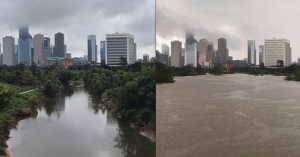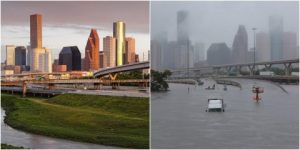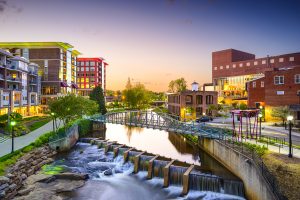Unbelievable photographs of the devastation in East Texas have been plastering our screens for over a week now. Hurricane Harvey is leaving his legacy with record-breaking rain, multiple landfalls, and mindboggling flooding. It is no doubt one of the worst storms I’ve lived to see, and could be one of the worst in our knowledgeable history. But before we dismiss this catastrophe as just another natural disaster, we should examine the reason behind the severity of the wide-spread destruction.


Before and after pictures of Houston
Houston, where much of the record flooding is taking place, is the United States fourth largest city, home to more than 6 million people in the entire metropolis area. The founders were looking for a place of opportunity for government and commerce, and the confluence of the White Oak Bayou and the Buffalo Bayou seemed perfect in 1836, until there were 16 major floods in the next 100 years. This prompted major flood control, which not only helped keep the town together, but also catalyzed major growth. And with major growth comes less and less pervious space for water to be absorbed.
Since 2001, there have been three 500-year floods in the Houston area. Now to be fair, if there was no Houston infrastructure and the area was left to be its natural prairie/marsh self, there would still be 500-year floods where the land would be far beyond its capacity to absorb large amounts of water. However, the increasing flood intensity cannot be ignored. Houston and many other cities are known for spontaneous and fast development, including major sprawl. This culture of unlimited development butts heads with nature, and the effects are not trivial. On top of the increased impervious areas, storms will continue to intensify due to climate change, and coastal cities will experience more powerful storm surges.
While we need to focus on immediate needs and bring people to safety, the situation begs the question of how development will respond to lessen the impacts of inevitable future flooding. If large cities are home to some of our largest problems, I believe they can produce some of our best solutions. Our cities aren’t getting any smaller, so we need to think creatively about how to be more resilient. For example, cities like Houston can encourage increasing and preserving natural prairies, creating green spaces, and restricting development in flood plains. Even our home of Greenville should exercise caution and thoughtfulness as our population continues to grow and production facilities increase. We need to become more adaptable and forward thinking because nature is not stopping anytime soon.
View of Greenville’s downtown Falls Park
What do you think Greenville can do to become more resilient?
-Hannah Dailey
